Excerpts from Jim Conrad's
NATURALIST Newsletter
from the February 8, 2019 Newsletter issued from Rancho Regenesis in the woods ±4kms west of Ek Balam Ruins; elevation ~40m (~130 ft), N20.876°, W88.170°; north-central Yucatán, MÉXICO
FLOPPERS FLOWERING
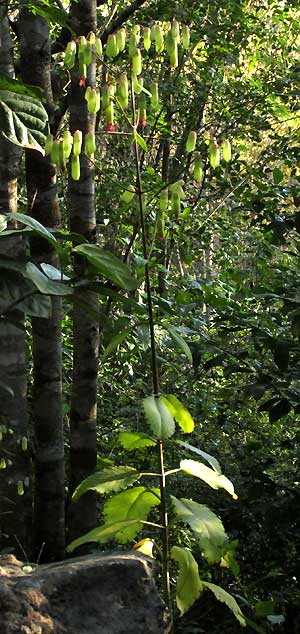 When I arrived at the rancho in late 2016, I found growing wild in the woods along the road a waist-high plant originally from Madagascar, but naturalized and "gone wild" in much of the world's tropical and subtropical zones. It was Bryophyllum pinnatum, known by numerous English names, among which my favorite is Floppers. A remarkable feature of this plant is that if you take what appears to be a leaf and keep it moist awhile, new little Flopper plants will sprout along the "leaf's" scalloped margins. That day in 2016 I collected a leaf and got from it several little plants, all documented at the bottom of this page.
When I arrived at the rancho in late 2016, I found growing wild in the woods along the road a waist-high plant originally from Madagascar, but naturalized and "gone wild" in much of the world's tropical and subtropical zones. It was Bryophyllum pinnatum, known by numerous English names, among which my favorite is Floppers. A remarkable feature of this plant is that if you take what appears to be a leaf and keep it moist awhile, new little Flopper plants will sprout along the "leaf's" scalloped margins. That day in 2016 I collected a leaf and got from it several little plants, all documented at the bottom of this page.
Floppers are perennial plants, which helps explain why during 2017 and 2018 my plants grew to about waist height but didn't flower. This year they did flower, and you can see in the picture at the right, showing the one beside the hut's sitting-rock, topped with a basketball-size flowering head.
A close-up of some of the flowering head's pale green things is shown below:
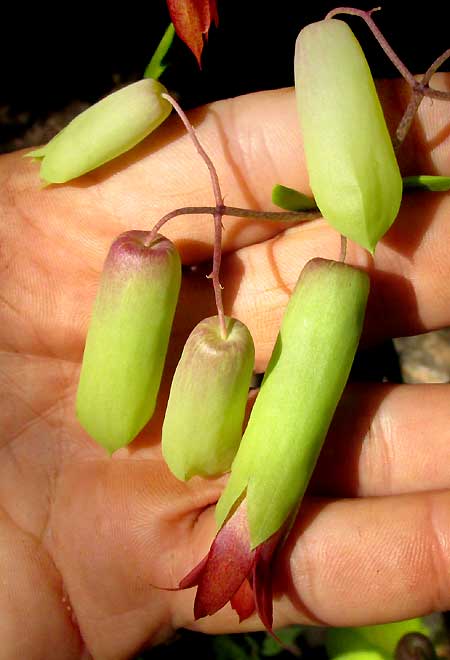
In that picture the largest item, at the lower right, is a blossoming flower, while the smaller, pale green items above the flower are flower calyxes expanded to form protective bladders around the immature corolla and sexual parts inside them. These much-inflated calyxes very conspicuously have been dangling there for several weeks now, glowing prettily during breakfast when back-lighted by the rising Sun. A calyx with one side removed, revealing the immature corolla within it is shown below:
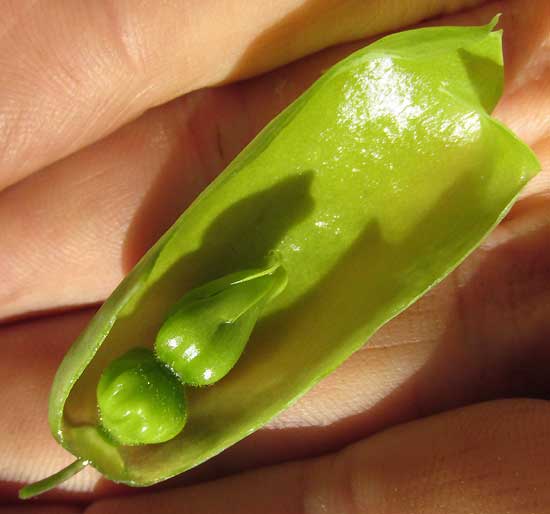
In that picture the green corolla at the inflated calyx's base is constricted in the middle, the corolla's bottom half appearing pea-like. A mature flower similarly with one side of its bladdery calyx removed is shown below:
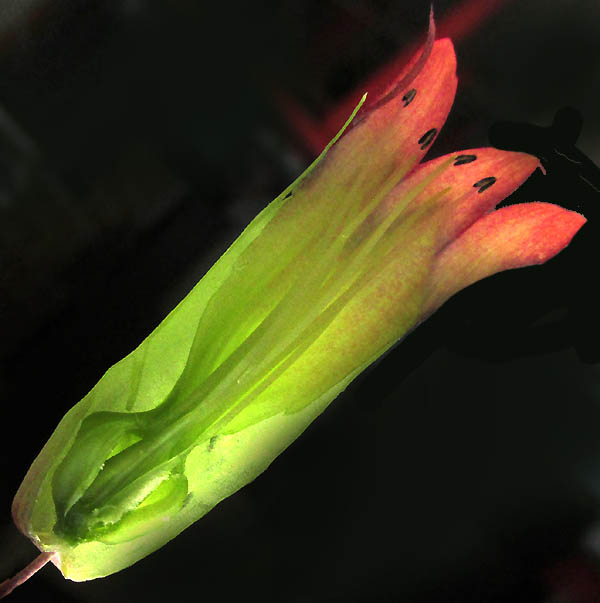
Now we can see that the corolla's pea-like bottom part, with part of its side removed, reveals itself as also bladder-like. This bulging bottom part of the corolla loosely surrounds four ovary divisions, which will develop into follicle-type fruits. Atop each future follicle rises a hard-to-see slender style terminated by a stigmatic, pollen-receiving zone. The four small black items opposite the rosy-colored corolla lobs are the stamens' pollen-producing anthers. The complete flower bears eight stamens.
A neat feature of all this is that the calyxes create large bladders, inside which the corolla pinches into a bladder-like bottom part -- a bladder inside a bladder. Cutting across the corolla's bottom bulge, you see what's shown below:
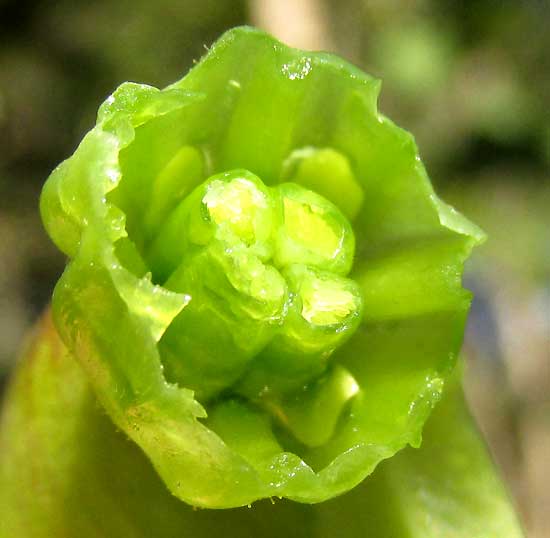
The four whitish items in the corolla's center are chopped off, future follicle-type fruits.
Hungry cattle roamed the forest in which in 2016 I collected the leaf from which all my plants derived, and I wondered why those wild succulent plants hadn't been eaten. Now I see that Floppers contain compounds called bufadienolide cardiac glycosides, which are known to cause heart problems, particularly among grazing animals. Two calves fed two days with Floper leaves died due to ataxia (loss of control of bodily movements) and irregular heartbeat.
But toxic plants often are medicinal in small dosages, so various cultures have been documented using the plant in traditional medicine, for ailments ranging from kidney stones, headaches and fevers to inflammations and cancer.
from the July 30, 2017 Newsletter issued from Rancho Regenesis in the woods ±4kms west of Ek Balam Ruins; elevation ~40m (~130 ft), N20.876°, W88.170°; north-central Yucatán, MÉXICO
FLOPPERS BUDDING
Late last year as the dry season was getting underway, in November or so, in the dusty, crinkly forest along the trail from the rancho to the main road, I noticed a scraggly, thick-leafed plant shriveling up in the dryness and losing some of its leaves. I knew this plant, and knew that its leaves, with scallop-margined blades about the size of a hamburger, did something special. A leaf was collected, tucked into my pocket, and when I returned to the rancho the leaf was placed on some moist soil in a pot. In only three or four days, at the indentations between several of the blade margins' crenations, tiny, white rootlets formed, mantled with almost microscopic root hairs. These formed on the leaf's underside. Below, you can see a picture of the rootlets on the flipped-upside down leaf:
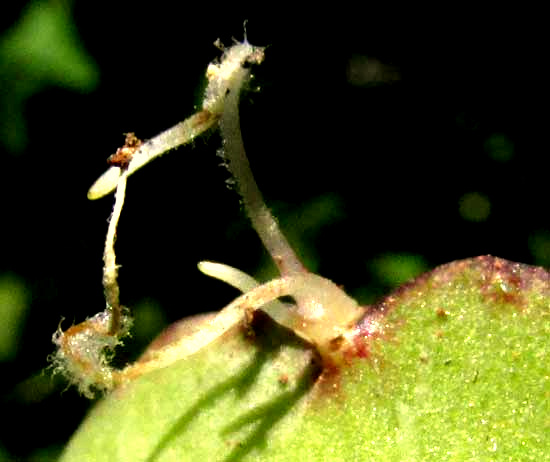
The leaf was carefully returned to its moist soil, the rootlets directed toward the soil, and in about a week little green sprouts appeared on the upper side of the leaf, from the same indentations. About three weeks later, the leaf appeared as shown below:
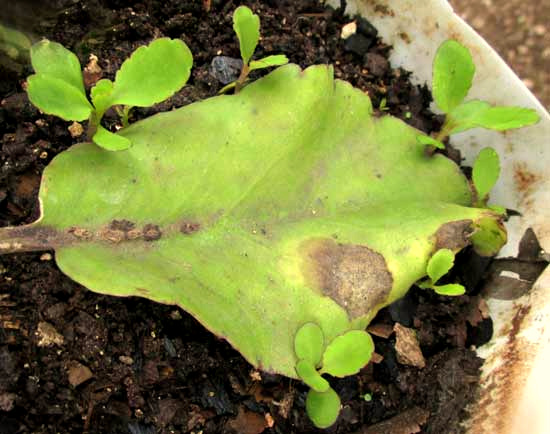
Once these sprouts along the leaf's margin were about finger high and crowding one another -- the leaf itself now withered and decaying -- some of the sprouts were transplanted to a spot near the hut so I could have the fun of watching it grow, and have souvenirs of the hot, wickedly dry day I stuffed the mama-leaf into my pocket. Nowadays the plants are about knee high. Below, you can see one:
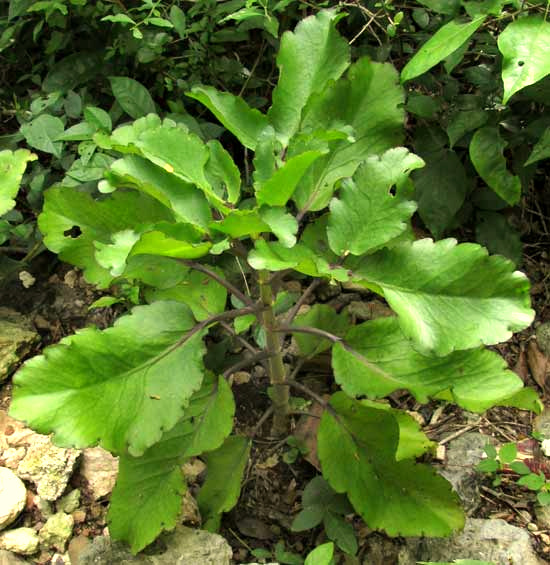
Something interesting about the young plants is that the first leaves to appear consist of just one blade on a petiole; they're "simple" leaves. But later on, they become "compound" leaves, consisting of three or five leaflets. Below, you can see a three-parted, or trifoliate, leaf -- its purplish petiole pointing toward the left:
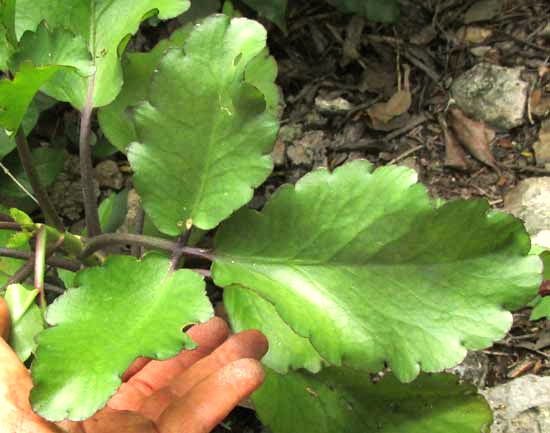
I knew this plant when I first saw it because it's a common houseplant, and because this species often is brought into biology classes to illustrate an example of "vegetative reproduction." In English is goes by many names, including Air Plant, Life Plant, Miracle Leaf, Floppers, Cathedral Bells, and Goethe Plant. (Goethe really liked it, talked about it a lot, and gave little sprouts to visitors, which I can do, too.) Unfortunately, none of those English names is much good, either because other unrelated plants share the same names, or their use is erratic. Up North, often Bromeliads are known as Air Plants. Anyway, the plant shown in our photos is BRYOPHYLLUM PINNATUM, native to Madagascar, but naturalized and "gone weedy" in much of the world's tropical and subtropical zones.
And now to undo some of the misleading statements made above: The items I've been calling leaves -- to keep from getting bogged down -- aren't really leaves. They're "phylloclades," which are stem branches, more or less flattened and functioning as and often looking like leaves. That explains how the Air Plant's "leaves" can produce new plants along their margins. They're not leaves at all, but rather stems branching and sprouting the way stems are supposed to. Christmas Cactuses consist of phylloclades.
When you see such juicy-looking plants with no spines, stinging hairs, or other obvious defenses, you wonder what's to keep herbivores from feeding on it. The answer is that they are toxic. Bryophyllum pinnatu contains compounds known as bufadienolide cardiac glycosides, capable of causing heart problems in grazing animals.
We've seen that when a plant is toxic, often in small doses it's also medicinal, and that's the case here, at least in traditional medicine. Though the Maya know nothing about it -- it wasn't in the Americas during the formation of the Maya pharmacopoeia -- in various places it's been used to treat hypertension, and its juice to cure kidney stones, though no scientific studies support these uses.